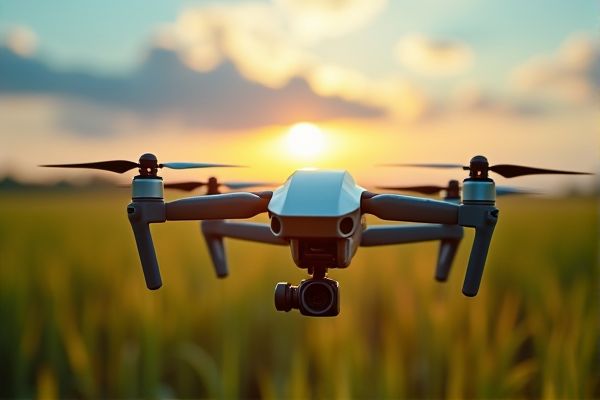
AI enhances agricultural drones by improving crop monitoring and analysis. These drones utilize advanced imaging technologies, such as multispectral and thermal sensors, to assess plant health and detect issues like pest infestations or nutrient deficiencies. Machine learning algorithms process the captured data, enabling farmers to make informed decisions about resource utilization and crop management. This technology not only boosts yield but also promotes sustainable farming practices by optimizing input use and minimizing environmental impact.
AI usage in agriculture drones
Precision Spraying
AI usage in agriculture, particularly in precision spraying, can significantly enhance crop management efficiency. Drones equipped with AI technology can analyze fields and determine the exact amount of pesticide or fertilizer required, minimizing waste and reducing costs. This targeted approach not only improves yield potential but also supports sustainable farming practices, as seen in projects by institutions like the University of California's Agriculture and Natural Resources department. The likelihood of benefiting from such advanced technologies suggests a promising future for farmers looking to optimize their operations.
Crop Monitoring
AI-powered drones can enhance crop monitoring by providing real-time data on plant health and soil conditions. These drones utilize advanced imaging techniques, such as multispectral and thermal imaging, to identify issues like pest infestations or nutrient deficiencies. Farmers using these technologies, similar to how institutions like NASA apply drone imagery for environmental studies, may experience improved yields and reduced resource waste. The possibility of integrating AI analytics further allows for targeted interventions, potentially increasing overall agricultural efficiency.
Soil Analysis
AI technology in agriculture drones offers the potential for enhanced soil analysis, enabling farmers to assess soil health and composition more accurately. By utilizing sensors and machine learning algorithms, these drones can identify nutrient deficiencies and optimize fertilizer application. This data-driven approach may lead to increased crop yields and reduced environmental impact. For example, the integration of AI with precision agriculture techniques can help institutions like USDA improve farming efficiency and sustainability.
Yield Prediction
AI applications in agriculture have the potential to enhance yield prediction significantly. By utilizing drones equipped with advanced sensors, farmers can collect high-resolution data on crop health and soil conditions. Such insights may lead to more informed decision-making and optimized resource allocation. Companies like PrecisionHawk are already exploring these technologies, providing farmers with essential tools to maximize their crop output.
Pest Detection
AI integration into agricultural drones enhances pest detection capabilities, allowing for precise monitoring of crop health. These drones utilize advanced algorithms to analyze imagery and identify areas affected by pests quickly. For instance, the application of machine learning models can provide farmers with actionable insights that facilitate timely intervention. This technology may lead to increased yield and reduced pesticide use, potentially resulting in significant cost savings for agricultural businesses.
Irrigation Management
AI integration in agricultural drones enhances precision in irrigation management by analyzing soil moisture levels and weather patterns. This data-driven approach enables farmers to optimize water usage, reducing waste and improving crop yields. For instance, an institution like the University of California has conducted studies showing how AI can predict irrigation needs more accurately. The possibility of increased efficiency through such technology suggests a significant advantage for agricultural productivity.
Field Mapping
AI technology in agriculture drones enhances field mapping accuracy by processing vast amounts of data quickly. This capability improves decision-making, potentially increasing crop yields and reducing waste. By utilizing AI algorithms, farmers can identify areas needing attention, such as irrigation or fertilization, based on detailed maps of their fields. For example, companies like PrecisionHawk are leveraging these technologies to provide actionable insights, demonstrating the tangible benefits of AI in agricultural practices.
Livestock Monitoring
AI usage in agriculture has the potential to significantly enhance the efficiency of drone operations for crop monitoring. These drones can utilize AI algorithms to analyze crop health and identify pest infestations, leading to more targeted interventions. Livestock monitoring through AI can improve animal health by providing real-time data on behavioral changes and vital signs. Institutions like the Agricultural Research Service are exploring these technologies to advance sustainable practices in farming.
Autonomous Navigation
AI-enhanced agriculture drones can optimize crop monitoring and yield prediction. Autonomous navigation systems improve efficiency by allowing drones to operate independently in challenging terrains. The integration of computer vision technology further enables precise targeting of areas needing attention, such as pest infestations. This advancement could significantly benefit farmers by reducing labor costs and increasing overall productivity.
Data Integration and Analytics
AI usage in agriculture drones can enhance precision farming by providing real-time data analysis on crop health and soil conditions. Data integration from multiple sources, such as weather forecasts and satellite imagery, aids in making informed decisions, potentially increasing yields. Drones equipped with AI algorithms can optimize resource allocation, thereby reducing waste and operational costs. For example, a university like Iowa State University conducts research on these technologies to explore their effectiveness in sustainable farming practices.
 techknowy.com
techknowy.com